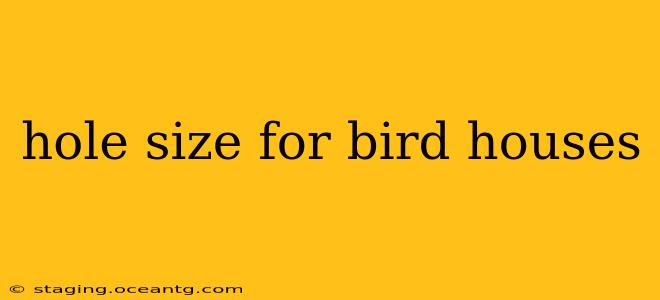Choosing the right hole size for your birdhouse is crucial for attracting the specific bird species you desire while deterring unwanted guests. Getting this detail wrong can mean the difference between a thriving bird family and an empty, unused house. This guide will delve into the ideal hole sizes for various birds, common mistakes to avoid, and other factors to consider for successful birdhouse construction and placement.
What Size Hole Do I Need for a Birdhouse?
This is the most frequently asked question, and the answer isn't a single number. The ideal hole size depends entirely on the type of bird you want to attract. Different species have different body sizes and nesting requirements. Here's a breakdown:
-
Small Birds (e.g., Chickadees, Wrens, Titmice): These tiny birds require a small entrance hole, typically between 1.125 inches (2.86 cm) and 1.25 inches (3.18 cm) in diameter. Anything larger risks attracting larger, more aggressive birds that could harm or displace them.
-
Medium-Sized Birds (e.g., Downy Woodpeckers, Nuthatches): Medium-sized birds need a slightly larger opening, generally between 1.25 inches (3.18 cm) and 1.5 inches (3.81 cm) in diameter.
-
Larger Birds (e.g., Bluebirds, Tree Swallows): Larger birds require a larger entrance hole, typically ranging from 1.5 inches (3.81 cm) to 1.75 inches (4.45 cm) in diameter. Houses for these birds also require larger overall dimensions.
It's crucial to research the specific birds in your region and choose a hole size appropriate for their needs.
What are the consequences of using the wrong hole size?
Using an incorrectly sized hole can lead to several problems:
-
Wrong Bird Species: Too large a hole will attract larger, potentially aggressive birds that might evict the intended occupants or even damage the nest. Too small a hole will exclude the desired species.
-
Predation: An improperly sized hole can make the birdhouse vulnerable to predators. If the hole is too large, raccoons, snakes, or larger birds could easily access and destroy the nest and eggs or chicks.
How do I measure the hole size accurately?
Accurate measurement is key. Use a ruler or caliper to ensure precision. A slightly too-small hole can be problematic, but a slightly too-large hole can create significant issues. Consider using a hole saw specifically designed for the required size. Sharp tools will ensure a clean cut.
What other factors besides hole size influence birdhouse success?
Beyond hole size, other crucial factors contribute to the success of your birdhouse:
-
Location: Choose a location that offers protection from the elements and predators, while also providing an unobstructed flight path.
-
Ventilation: Ensure proper ventilation to prevent overheating and the build-up of moisture inside the house.
-
Materials: Use weather-resistant, untreated wood or other appropriate materials.
What is the best wood for building a birdhouse?
Untreated, durable wood is ideal. Cedar and redwood are popular choices due to their natural resistance to decay and insects. Avoid using treated lumber as it can be toxic to birds.
Are there different hole sizes for different types of birds?
Yes, absolutely. The hole size needs to be tailored to the size of the bird. A small bird will not be able to enter a large hole, and a large bird may not fit in a small hole.
How do I know what birds live in my area?
A local Audubon Society chapter, a nature center, or a good field guide to birds can help you identify the bird species in your area. This will help you choose the appropriate size of birdhouse and hole diameter.
By carefully considering the hole size and other factors outlined above, you can significantly increase your chances of attracting the desired birds to your backyard and enjoying their presence. Remember, research is key – understanding the specific needs of local birds is the first step to successful birdhouse construction.
